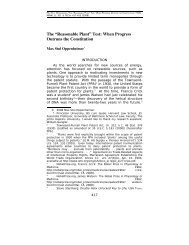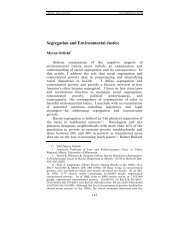An Organizational Approach to the Design of Patent Law
An Organizational Approach to the Design of Patent Law
An Organizational Approach to the Design of Patent Law
Create successful ePaper yourself
Turn your PDF publications into a flip-book with our unique Google optimized e-Paper software.
6 VERTINSKY FINAL_JAD (DO NOT DELETE) 2/27/2012 2:20 PM<br />
2012] AN ORGANIZATIONAL APPROACH 229<br />
and o<strong>the</strong>r collective structures. 70 Organizations are not only<br />
players in <strong>the</strong> game, but are also involved in shaping and<br />
changing <strong>the</strong> rules <strong>of</strong> <strong>the</strong> game; “[i]t is <strong>the</strong> interaction between<br />
institutions and organizations that shapes <strong>the</strong> institutional<br />
evolution <strong>of</strong> an economy.” 71<br />
As an example <strong>of</strong> what <strong>the</strong>se terms mean in practice, <strong>the</strong><br />
Bayh-Dole Act changed <strong>the</strong> rules regarding ownership <strong>of</strong> inventions<br />
developed using public funding, allowing universities and<br />
o<strong>the</strong>r research entities <strong>to</strong> elect title <strong>to</strong> patents obtained for such<br />
inventions—a change in <strong>the</strong> rules <strong>of</strong> <strong>the</strong> game. 72 As a result,<br />
universities and o<strong>the</strong>r research entities began <strong>to</strong> work in new<br />
ways with industry partners, including licensing arrangements<br />
and o<strong>the</strong>r forms <strong>of</strong> collaboration previously unavailable—a<br />
change in governance, or how <strong>the</strong> game is played. 73 The effects<br />
<strong>of</strong> this rule change <strong>to</strong>ok place within an institutional environment<br />
that has modified <strong>the</strong> behavioral responses <strong>to</strong> <strong>the</strong> rule<br />
change in ways that are still being explored. 74<br />
B. WILLIAMSON’S METHODOLOGY<br />
While much <strong>of</strong> <strong>the</strong> work done in NIE takes <strong>the</strong> form <strong>of</strong> a<br />
particular <strong>the</strong>oretical and/or methodological approach <strong>to</strong> economic<br />
behavior, Williamson is one <strong>of</strong> <strong>the</strong> few <strong>to</strong> <strong>of</strong>fer both a<br />
broad analytical framework for studying <strong>the</strong> organization <strong>of</strong><br />
economic activity and a way <strong>of</strong> operationalizing his conceptual<br />
framework. 75 Williamson provides a system-based approach <strong>to</strong><br />
<strong>the</strong> study <strong>of</strong> economic activity, anchoring individual transactions<br />
within a social, legal, economic, and political context. 76 Alternative<br />
mechanisms for coordinating economic activity are<br />
examined in <strong>the</strong> face <strong>of</strong> bounded rationality, opportunism, and<br />
70. See Joskow, supra note 59, at 5–6 (discussing <strong>the</strong> core principles <strong>of</strong> <strong>the</strong><br />
NIE research approach).<br />
71. North, Economic Performance through Time, supra note 60, at Part<br />
III.<br />
72. See Bayh-Dole Act, 35 U.S.C. §§ 202–212 (2006).<br />
73. See Jerry G. Thursby & Marie C. Thursby, University Licensing and<br />
<strong>the</strong> Bayh-Dole Act, 301 SCI. 1052, 1052 (2003) (emphasizing that while it is<br />
clear that licensing has an effect on university technology transfers, more research<br />
is needed <strong>to</strong> fully understand <strong>the</strong> impacts licensing brings <strong>to</strong> <strong>the</strong> research<br />
environment).<br />
74. See id. (explaining that though licensing by universities has increased<br />
dramatically, <strong>the</strong> effects on <strong>the</strong> research environment are unclear).<br />
75. See Oliver E. Williamson, The New Institutional Economics: Taking<br />
S<strong>to</strong>ck, Looking Ahead, 38 J. ECON. LITERATURE, 595, 595–96 (2000).<br />
76. See id. at 596–97.






